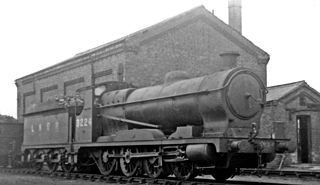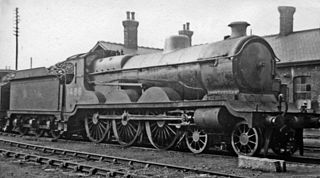John George Robinson CBE, was an English railway engineer, and was chief mechanical engineer of the Great Central Railway from 1900 to 1922.
The London and North Eastern Railway (LNER) produced several classes of locomotive, mostly to the designs of Nigel Gresley, characterised by a three-cylinder layout with a parallel boiler and round-topped firebox. It produced the most famous locomotive of its day, 4468 'Mallard', the holder of the world steam locomotive speed record. It also built the world-famous 4472 'Flying Scotsman'. However, its locomotive inheritance was much greater than just the 'A4 Class', it also produced highly successful mixed-traffic and freight designs.

The Great Central Railway (GCR) Class 9F was a class of 0-6-2T steam locomotive built between 1891 and 1901. From 1923 the locomotives were redesignated Class N5.

Stephen Dewar Holden was a British engineer, the son of the engineer James Holden and succeeded his father as locomotive superintendent of the Great Eastern Railway in 1908, a post he held until his retirement in 1912.

The North Eastern Railway (NER) Class Y 4-6-2T tank locomotives were designed whilst Wilson Worsdell was Chief Mechanical Engineer, but none were built until 1910 by which time Vincent Raven had taken over.

The NER Class X was a class of 4-8-0T tank locomotive designed by Wilson Worsdell for the North Eastern Railway. They were intended for use as powerful shunting engines to arrange and move coal wagons for loading into ships. In total 15 were built, 10 by the NER between 1909 and 1910, and a further five in 1925 by the London and North Eastern Railway (LNER). They had three cylinders with divided drive: the inside cylinder driving the leading axle, the outside cylinders driving the centre.

The Great Central Railway (GCR) Class 8A was a class of 0-8-0 steam locomotive built between 1902 and 1911 for handling heavy coal trains over the Pennines. They all passed to the LNER in 1923, who redesignated them Class Q4. They were withdrawn from service between 1934 and 1951.
The NER Class W1 was a 4-6-2T steam locomotive of the North Eastern Railway. The class was introduced in 1914 as a rebuild of Wilson Worsdell's NER Class W 4-6-0T. At the 1923 Grouping, they all passed to the London and North Eastern Railway, who placed them in their Class A6.

The GCR Class 1B was a class of 2-6-4T (tank) locomotives on the Great Central Railway. They were notable as the first locomotives of the 2-6-4T wheel arrangement to be used by a British standard-gauge railway; there had been two narrow-gauge examples on the Leek & Manifold Valley Light Railway since 1904.
Although overshadowed by the later and more famous steam locomotives that John G. Robinson would go on to design, the Great Central Railway Class 11B 4-4-0 Express Passenger engines were a successful class which totalled 40. Built from 1901 to 1903, in later rebuilt form as 11D, some 11Bs would last in service until 1950. Railwaymen continued to refer to the class as "11B" even after all were rebuilt to 11D. Being contemporary with and to some extent the 4-4-0 version of Robinson's much more numerous 0-6-0 goods class 9J, which were known as "Pom-Poms", the 11Bs acquired the nickname "Pom-Pom Bogies". The London & North Eastern Railway classified the 11Bs, along with their 11C and 11D rebuilds, as Class D9.
The LD&ECR Class D was a class of nine 0-6-4T steam locomotives supplied to the Lancashire, Derbyshire and East Coast Railway in 1904 and 1906 by Kitson & Co. of Leeds. They later became the property of the Great Central Railway and finally the London and North Eastern Railway, upon which they were known as Class M1.
GCR Classes 8D and 8E were two pairs of three-cylinder compound steam locomotives of the 4-4-2 wheel arrangement built in 1905 and 1906 for the Great Central Railway.

The GCR Class 11E was a type of 4-4-0 steam locomotive used by the Great Central Railway for express passenger services. Ten were built in the railway's own workshops at Gorton, Manchester during 1913; they remained in service until the mid-1950s.

The GCR Class 9Q, classified B7 by the LNER, was a class of 4-6-0 mixed traffic locomotives designed by John G. Robinson for fast goods, relief passenger and excursion services on the Great Central Railway. They were a smaller wheeled version of Robinson's earlier Class 9P "Lord Faringdon" express passenger class.

The GCR Class 9J was a class of 174 0-6-0 steam locomotives designed by John G. Robinson for freight work on the Great Central Railway (GCR) in 1901. They were a part of the Railway Operating Division during World War 1.

The Great Central Railway Class 1A, classified B8 by the LNER, was a class of 4-6-0 mixed-traffic locomotives designed by John G. Robinson for fast goods, relief passenger and excursion services. They were known as the ‘Glenalmond Class’ and were a smaller wheeled version of Robinson's earlier Sir Sam Fay express passenger class, which they closely resembled.

The Great Central Railway (GCR) Class 9A was a class of 0-6-2T steam locomotive built between 1889 and 1892. From 1923 the locomotives were redesignated Class N4.
The GCR Class 8C was a class of a pair of 4-6-0 locomotives built for the Great Central Railway in 1903–1904 by Beyer, Peacock and Company. They passed to the London and North Eastern Railway at the 1923 grouping and received the classification B1 They were reclassified B18 in 1943 and both were retired in 1947.

The GCR Class 8F was a class of ten 4-6-0 locomotives built for the Great Central Railway in 1906 by Beyer, Peacock and Company to the design of John G. Robinson for working fast goods and fish trains. They passed to the London and North Eastern Railway at the 1923 grouping and received the classification 'B4'.
The NER Class W was a class of ten 4-6-0T locomotives built by the North Eastern Railway at their Gateshead Works between 1907 and 1908. They were all rebuilt as Class W1 4-6-2T locomotives between 1914 and 1917.












